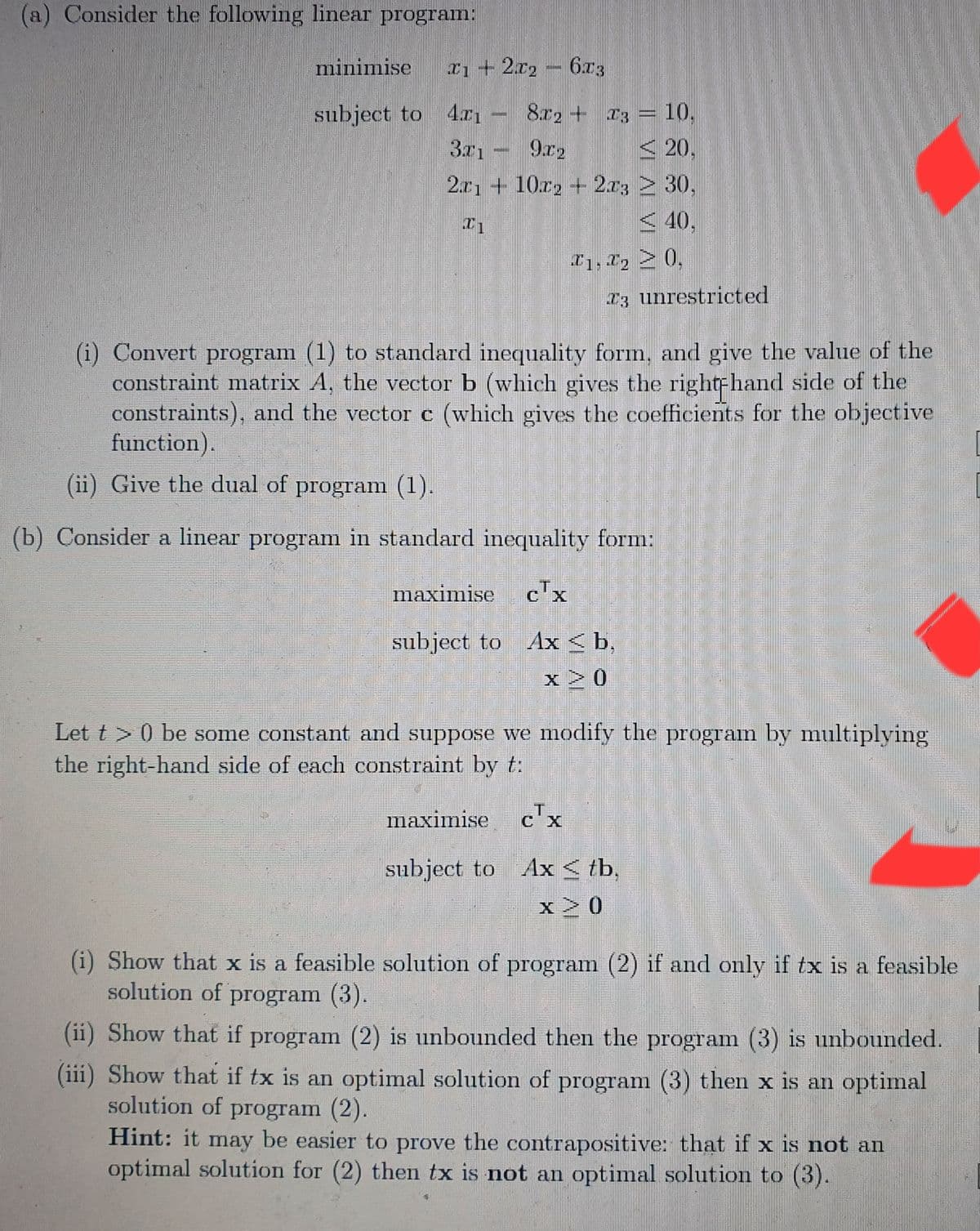O Consider the following linear program: minimise x1 + 2x2 - 6x3 subject to 4₁ - 8x2 + x3 = 10, 3x19x2 ≤ 20, 2x1 + 10x2 + 2x3 ≥ 30, I1 ≤ 40, X1, X₂ ≥ 0, T3 unrestricted (i) Convert program (1) to standard inequality form, and give the value of the constraint matrix A, the vector b (which gives the right hand side of the constraints), and the vector c (which gives the coefficients for the objective function). (ii) Give the dual of program (1).
O Consider the following linear program: minimise x1 + 2x2 - 6x3 subject to 4₁ - 8x2 + x3 = 10, 3x19x2 ≤ 20, 2x1 + 10x2 + 2x3 ≥ 30, I1 ≤ 40, X1, X₂ ≥ 0, T3 unrestricted (i) Convert program (1) to standard inequality form, and give the value of the constraint matrix A, the vector b (which gives the right hand side of the constraints), and the vector c (which gives the coefficients for the objective function). (ii) Give the dual of program (1).
Algebra & Trigonometry with Analytic Geometry
13th Edition
ISBN:9781133382119
Author:Swokowski
Publisher:Swokowski
Chapter9: Systems Of Equations And Inequalities
Section9.3: Systems Of Inequalities
Problem 15E
Related questions
Question

Transcribed Image Text:(a) Consider the following linear program:
minimise
x1 + 2x2 673
HILING
subject to
4x1
8x2 + x3 = 10,
73
3x1
9.12
≤20,
2.r1 + 10.x2 + 2.73 30,
I1
≤ 40,
I1, I₂ > 0.
T3 unrestricted
(i) Convert program (1) to standard inequality form, and give the value of the
constraint matrix A, the vector b (which gives the right hand side of the
constraints), and the vector c (which gives the coefficients for the objective
function).
(ii) Give the dual of program (1).
(b) Consider a linear program in standard inequality form:
maximise
cx
subject to Ax ≤ b,
X>0
Let t > 0) be some constant and suppose we modify the program by multiplying
the right-hand side of each constraint by t
maximise
cTx
subject to
Ax ≤ tb,
x>0
(i) Show that x is a feasible solution of program (2) if and only if tx is a feasible
solution of program (3).
(ii) Show that if program (2) is unbounded then the program (3) is unbounded.
(iii) Show that if tx is an optimal solution of program (3) then x is an optimal
solution of program (2).
Hint: it may be easier to prove the contrapositive: that if x is not an
optimal solution for (2) then tx is not an optimal solution to (3).
Expert Solution
This question has been solved!
Explore an expertly crafted, step-by-step solution for a thorough understanding of key concepts.
Step by step
Solved in 2 steps with 1 images

Recommended textbooks for you

Algebra & Trigonometry with Analytic Geometry
Algebra
ISBN:
9781133382119
Author:
Swokowski
Publisher:
Cengage

Algebra: Structure And Method, Book 1
Algebra
ISBN:
9780395977224
Author:
Richard G. Brown, Mary P. Dolciani, Robert H. Sorgenfrey, William L. Cole
Publisher:
McDougal Littell

Algebra & Trigonometry with Analytic Geometry
Algebra
ISBN:
9781133382119
Author:
Swokowski
Publisher:
Cengage

Algebra: Structure And Method, Book 1
Algebra
ISBN:
9780395977224
Author:
Richard G. Brown, Mary P. Dolciani, Robert H. Sorgenfrey, William L. Cole
Publisher:
McDougal Littell